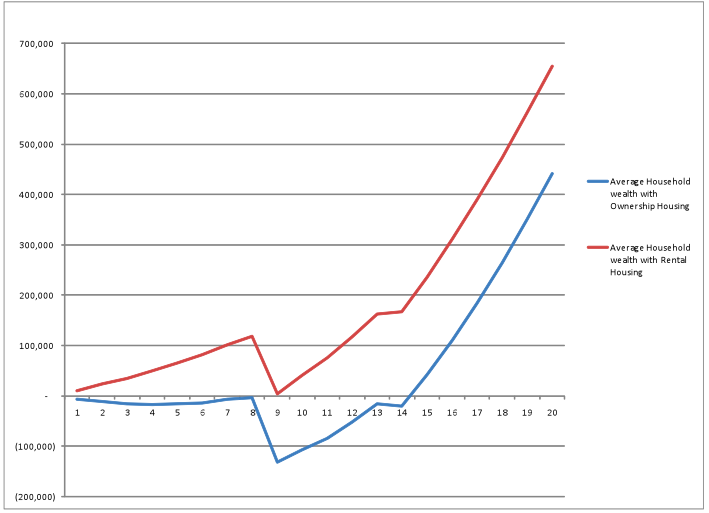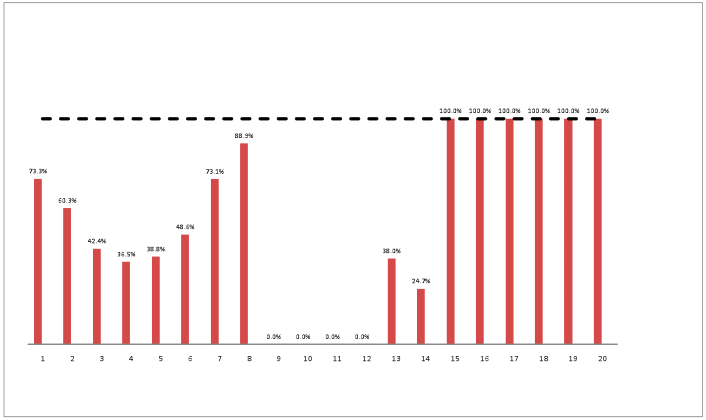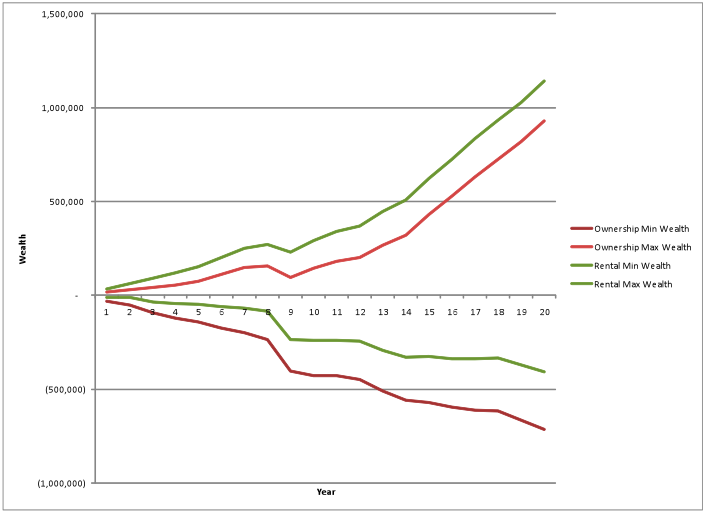Increasing urbanization and massive demographic pressures that India is witnessing has brought housing and infrastructure to centre stage. The challenge of providing affordable housing to low-income households is a critical issue to be addressed particularly in light of the 24.7 million housing units shortage as estimated in the Eleventh Five Year Plan. The issue becomes all the more pressing when we understand that 99% of this demand emanates from low-income households.
The traditional Indian response to meet the housing challenge has been biased towards ownership based models, with the concept of rental housing remaining largely unexplored. However, an examination of the risks peculiar to low-income households and an understanding of their financial situation could help us understand that top-down approaches like ownership housing, that does not consider the financial well-being of the low-income households, may not be the right housing strategy for the government to pursue.
An Intuitive Case for Rental Housing
First, the earning members of a low-income household are usually employed in the informal sector, with no job-security. This implies that their income streams display a high level of volatility and substantial variation over time. The low-income households are also usually the financially excluded segment, with no timely access to finance.
In this context, the ownership based housing models with loan components have a high risk of default. Rental housing, on the other hand, could offer the flexibility of moving to a cheaper accommodation, thus dealing better with instability in income streams.
Second, after meeting its basic consumption expenditure, a low-income household must consider the options to park its surplus wealth. Building stores of value in physical assets like real estate may not be the best option due to its high risk and high correlation with local economic conditions. A safe bet for a low-income household would be to invest in financial assets that offer a high degree of liquidity and have a low correlation with domestic conditions.
In this context, in the case of an economic downturn when the earning members lose their job, home ownership would not help the household tide over the economic mire as housing prices are likely to be depressed during the period. On the other hand, rental housing by offering greater flexibility enables them to adjust their housing expenses in light of the surplus available.
Third, the very nature of employment in the informal sector implies vulnerability to the risk of wage loss and unemployment. Thus, migration in search of better socio-economic opportunities, especially in economic downturns, is an essential characteristic of low-income households.
In light of mobility, it must be noted that home ownership makes a household spatially bound and constrains the opportunity to improve the household’s economic conditions. With mobility being crucial to the survival of the low-income households, ownership housing acts against the best interest of the household.
An Empirical Case for Rental Housing
To strengthen the intuitive case made above for ownership housing, we examine the housing choice facing low-income households from an empirical standpoint. We perform a simulation-based scenario analysis to make a clear case for the desirability of rental housing over ownership housing.
We attempt to capture the various uncertainties and risks confronting the low-income household by taking account of contingencies, unforeseen expenses and big ticket items in the analysis. We examine the wealth paths of a typical five-member low-income household under the two housing options, ownership and rental housing, over a 20 year horizon.
Assumptions for the Analysis
• The five member household under consideration has two primary wage earners, two children and one senior citizen.
• The earning members are employed in the construction industry in the informal sector.
• The male wage earner earns a monthly income of Rs. 4500 and the female wage earner earns an income of Rs. 3000.
• To model the employment risk and volatility in income streams of low-income households employed in the informal sector, we assume that each wage earner can be employed anywhere between 6 and 12 months in a year.
• To capture the unforeseen hospitalization events that influence the wealth of the household, we simulate health shocks. We model health expenses based on data from the NSS (average expenses per hospitalization event is estimated to be around Rs. 9800) and using probability distribution of households reporting hospitalization events.
• To account for the possible death of any member in the family, we simulate the life of each member based on his current age. We use the mortality data published by the Actuaries of India for this purpose. Modeling the death risk is particularly important as the death of the wage earners has a direct bearing on the financial well being of the household as it has no financial protection in the event of an untimely death of its bread winners.
• To model non-routine big-ticket expenses that strain the household’s overall wealth, we include the expenses relating to wedding. We assume that the marriage age is 21 and the mean wedding expense for a daughter is estimated to be Rs 95,956 (based on a study by Andrist and Desai, 2010), and we make the assumption that the marriage of a boy costs a quarter of the expenses for a girl. We also assume that once a member is married, he/ she no longer forms a part of the original household.
• We assume that inflation for a given year is a random deviation from the 10 year (1997-2007) historical average, we simulate inflation for the 20 year period and adjust the income and all expenses by the rate of inflation.
Income and Expenditure
The annual income of the household would be the wage of each earning member times the number of months he/ she is employed adjusted for inflation. With regard to expenditure, based on the Max New York Life- NCAER India Financial Protection Survey we include estimates of routine expenditure – food, education, health, clothes, transport – that cannot be compromised by the household and non-routine expenditure that include big-ticket items like expenses related to wedding and unplanned contingency expenditure like those related to health emergencies.
Wealth Paths of Households
To examine the suitability of ownership versus rental housing for the low-income households we consider the wealth paths of the household under the two scenarios.
Scenario 1: Ownership Housing
We assume that the equal monthly installments (EMI) do not exceed 30% of the monthly income of the low income household (as per the recommendation of the Deepak Parikh Committee on Affordable Housing). For the low-income household under consideration with a household monthly income of Rs. 7500, the maximum EMI works out to be Rs. 2250.
Considering a mortgage of Rs. 2.3 lakhs at 10% per annum, for a 20 year period, the EMI is Rs. 2220, within the maximum EMI limit. Assuming the banks finance 75% of the value of the house, a mortgage of Rs. 2.3 lakhs implies that the value of the house under consideration is Rs. 3.07 lakhs. The housing expenses under this scenario would be the annual EMI expenses, which works out to be Rs. 26640.
The annual wealth surplus for the household under ownership housing is calculated by accounting for all expenses (routine and non-routine expenses mentioned above including the housing expenses) and carrying forward the surplus wealth from the previous period.
Scenario 2: Rental Housing
Assuming the same house as in ownership housing, but under a rental scheme, we use the monthly rent equivalent of Rs. 807 (obtained on the basis of an average rent to EMI ratio of 2.75) to account for housing expenses. Capturing the flexibility that rental housing affords for moving to a cheaper accommodation in the event of an economic stress, we assume that the minimum rental expense that a household must incur to live in the city is Rs. 500.
Thus, in the case of rental housing, the annual surplus is calculated in a manner similar to the case under ownership housing, with the only difference of being able to capture the flexibility of moving to a minimum rental accommodation in the event that the household’s surplus (excluding housing expenses) falls short of the annual rent equivalent of the house under ownership.
Running 100 simulations of the wealth paths of households under ownership and rental housing, we find that the average wealth paths of low-income households are better off under rental housing than under ownership housing.
Under ownership housing we find that the surplus is negative for a considerably long period, for 14 out of the 20 years under consideration, and that the household is unable or only partially able to service its mortgage obligations. On the other hand, under rental housing, the average wealth path remains positive over the entire period. The only blip occurs during the year of the daughter’s wedding and springs back to higher levels of surplus after the event. The flexibility of moving to a cheaper accommodation serves the household well, as demonstrated in the year when its surplus fell below the required rental payment to continue in an accommodation similar to the one under ownership housing.
Figure 2 further illustrates the fact that under ownership housing, the household is unable to service its debt obligations completely for the first 14 years. This suggests loan default and repossession of the house by the lender, against the best interest of the low-income households.
To gain an understanding of the universe of wealth paths for the household, we consider the wealth envelope of the household, as in Figure 3, which depicts the best case and worst case wealth paths of the household. The wealth envelope also gives a sense of the distribution of wealth paths along the zero wealth line through the area between the best and worst wealth scenario.
The red and green lines portray the wealth paths under ownership and rental housing respectively. We observe that the best and the worst case of household wealth occur under rental housing rather than ownership housing. The ownership wealth envelope has an equal distribution above and below the zero wealth line and is in some sense even skewed below the zero wealth line. On the other hand, the wealth envelope under rental housing presents a positive annual surplus, and is in fact skewed above the line.
Our empirical analysis, presents a clear case in support of rental housing over ownership housing. Rental housing strategies could spell an end to the debt traps that low-income households are unwittingly dragged into, lifting them from the mire of poverty. Rental housing, by reducing the risk that the surplus dips below zero, would be the ideal risk minimizing strategy for low-income households.
In light of the intuitive and empirical arguments, we have a clear case for the government to consider rental housing models as opposed to directing its attention on just ownership housing strategies for low-income households.
The detailed theoretical and empirical case for rental housing can be found in this paper.







3 Responses
Compliments on a very interesting study. A few points to ponder (since the end objective is to provide decent housing and a savings route to low income groups / informal sector earners):
1.Rentals will always be lower the financing of ownership, similar experience for high income groups but latter has advantage of capital appreciation
2. Glitch in housing at low cost primarily an urban phenomena where high land costs (if available) take it out of the hands of low income groups.
3. The minute you have good infrastructure housing (water, elec, sewerage), house prices in urban locations skyrocket. Selling the house / sub-letting becomes financially more attractive and at prices that pull in non-low income groups. This is the classic problem faced all City Dev Auth who make LIG flats for instance. A way around this is a PPP style private owner manager with usage controls of the housing.
4. housing needs to be close to area of work, which means land prices freak out. eg these workers don’t want to commute 2 hrs each way given they often commence very early and finish very late plus need to be on call at short notice.
5. assuming other constraints can be handled, if we can treat rental as EMI retrospectively subject to minimum tenure (more as a safeguard), atleast stable residence workers can aspire to create wealth. happy to elaborate this over personal mail / ph:
6. given that in urban locations there is always some cost to housing even if by way of hafta, it would interesting to just evaluate alternatives against this price that is definitely paid by LIGs and ignore the impact of marriage, health etc. which may just complicate things further in development of a financing instrument.
just sharing thoughts, hope some contribute to your efforts.
Dear Prasanna, Thanks for your comment. You raise some very interesting points. Some thoughts:
I think you raise a very important point on capital appreciation, and the fact that ownership housing enables households to build value over time. This is true, but as the analysis shows (Figure 2), the precarious economic position of the households in question will, on average, force them into default beofre they realise any capital appreciation. This is the crux of the case for the need for rental solutions for the poorest.
The need to have private participation in the creation of rental houisng for low income households, using, as you suggest, PPP models and instruments such as REITs will be critical in addressing the tremendous need for such housing.
Hi Anand,
I read your article today only. Many congratulations for writing this quite a thought provoking article.
I was wondering, if a family belonging to lower income group is living on rent in a premises for more than 5 years and then stops paying rent to the owner, what is the possibility that they can be evacuated for non-repayment of rent? Using legal means require lot of time and money and still you don’t know the time-line of resolution.
Govt is providing land/ flats (e.g JNNURM scheme) to slum dwellers in resettlement colonies and people are are required to pay small sum (kind of rent) to govt for a period of 20-30 years. As far as i know, very few pay the required amount.
The mindset is that if low income people are not paying rent etc it is OK. It is the duty of Govt. to provide them free/ highly subsidized accomodation. Wherever is subsidy the corruption follows and we know what is the end result.
So who will build the houses for rent?